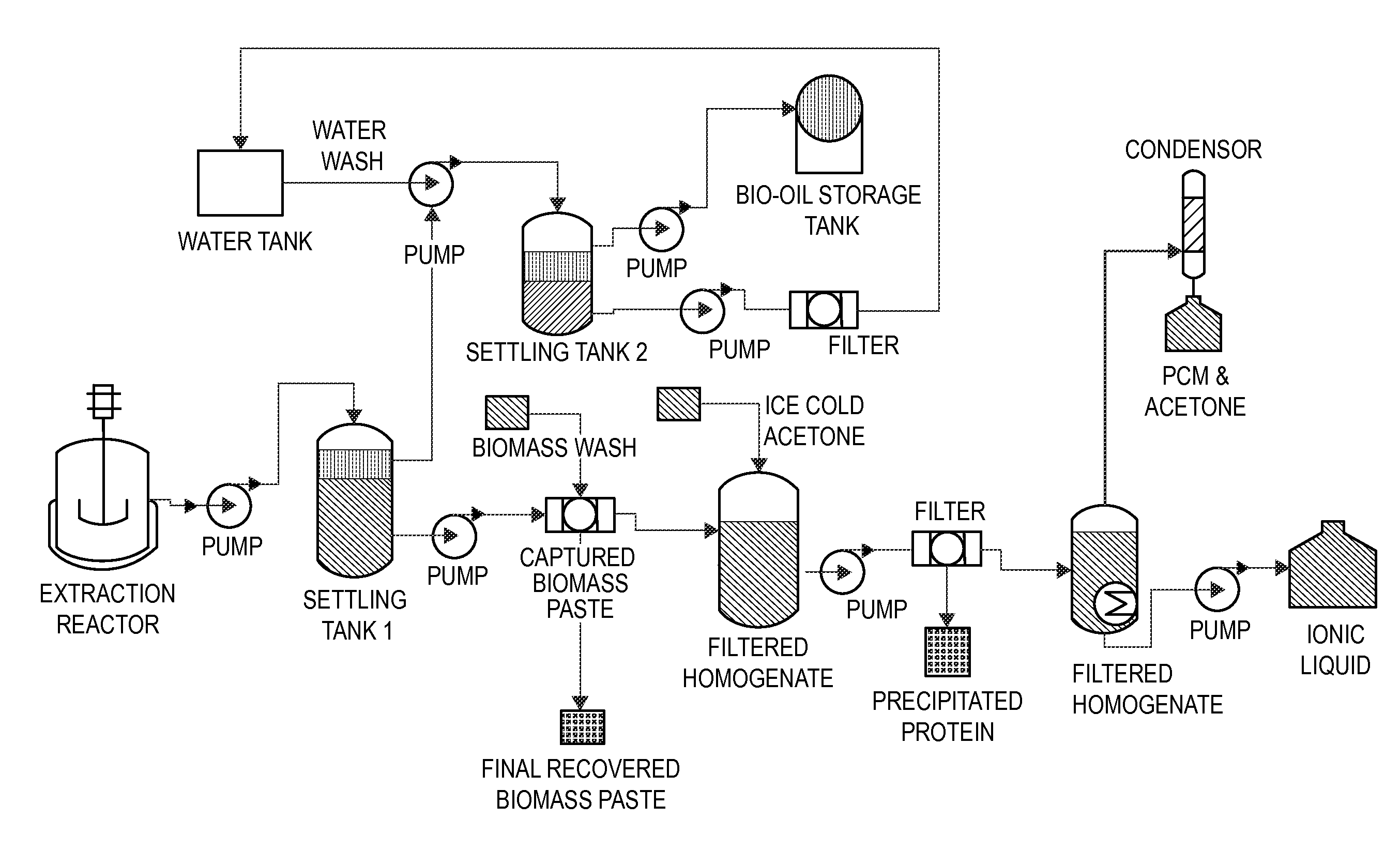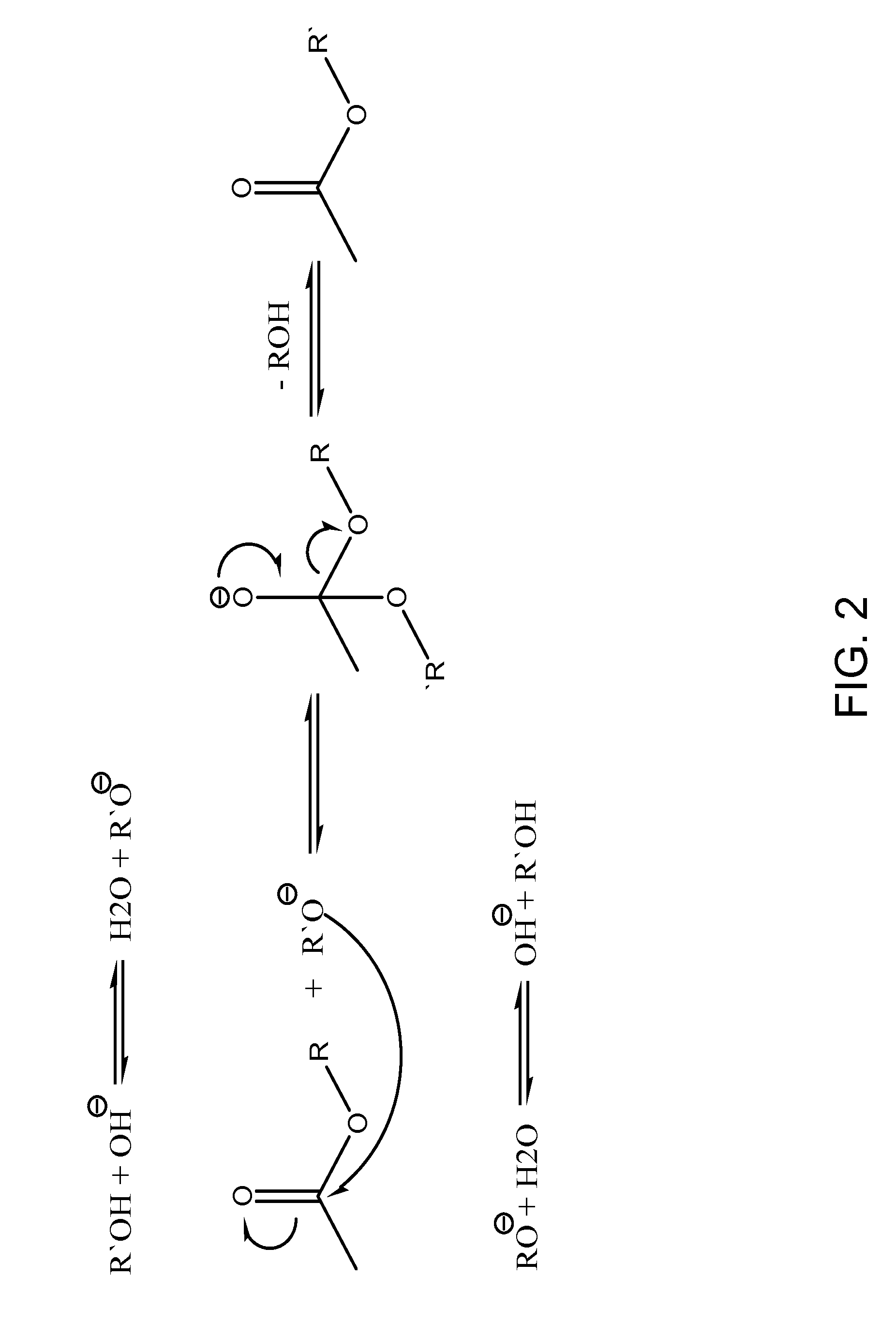Methods and compositions for extraction and transesterification of biomass components
a biomass and composition technology, applied in the direction of fatty oil/acid recovery from waste, fatty oil/fat refining, separation processes, etc., can solve the problems of preventing its development and large-scale use, time for gc analysis, and diminishing the voluminous use of flammable alcohol
- Summary
- Abstract
- Description
- Claims
- Application Information
AI Technical Summary
Benefits of technology
Problems solved by technology
Method used
Image
Examples
example 1
Recovery of Bio-Oils from Microalgae and from Yeast in Multiple Steps Using Established Techniques
[0208]A standard extraction approach was employed to estimate the total percentage of extractable bio-oils held within microalgal and yeast biomass. Briefly, samples were dried, pulverized, weighed and subsequently exposed to chloroform-methanol solvent. After the extraction was completed, water was added to the solution to bring about a separation of the biomass-containing methanol phase from the lipid-containing chloroform phase. In order to measure the percentage of extracted bio-oils that can be transesterified (i.e. free fatty acids or triglycerides), the extracted material was subsequently transesterified into fatty acid methyl esters (FAMES) for analysis by gas chromatography (GC) or NMR (Lewis, et al. 2000. “Evaluation of extraction methods for recovery of fatty acids from lipid-producing microheterotrophs.”Journal of Microbial Methods 43:107-116, which is incorporated herein by...
example 2
Production of Fatty Acid Esters (i.e. Biodiesel) from Nannochloropsis Microalgae by Direct Transesterification in Excess Methanol Solvent
[0216]Initial experiments were performed on commercially purchased microalgae (i.e. Nannochloropsis). This strain was shown to possess approximately 10% to 15% (w / w) of nonpolar extractable components (a portion of which are lipids, some of which are transesterifiable and some which are not, and a portion which are pigments). Direct transesterification of lipids within Nannochloropsis was studied under a range of conditions. In a first series of experiments, direct transesterification on dried Nanochloropsis cells was conducted in the presence of excess methanol and acid catalyst, followed by subsequent extraction of reaction with hexane solvent.
[0217]Nannochloropsis biomass was dried and prepared as described in Example 1. For each experiment, a known amount of biomass (for example, 100 (±10) mg) was transferred into screw top test tubes and subme...
example 3
Production of Fatty Acid Esters (i.e. Biodiesel) from Chlorella protothecoides Microalgae (Grown on Glucose in the Dark) by Direct Transesterification in Excess Methanol Solvent
[0222]Direct transesterification of C. protothecoides biomass was carried out in excess methanol solvent as described in Example 2. The direct transesterification of Chlorella biomass using excess methanol as solvent and a reaction time of 5 hours yielded a fatty acid methyl ester (FAME) concentration on the order of 36% (w / w) that converted the majority of bio-oil (i.e. fatty acids and triglycerides) to FAME product (Table 5, Experiment FN 20-2). Increasing the reaction time to 12 hours did not increase the yield (Table 5, Experiment FN 23-3), confirming this observation. In addition, the weight percent of FAME product (Table 5, Experiments FN 20-2 and FN 23-3) matched the total amount of bio-oil extracted from C. prototheocoides (Table 3, Experiments FN 10 and FN 19), further supporting the observation that...
PUM
| Property | Measurement | Unit |
|---|---|---|
| temperature | aaaaa | aaaaa |
| melting points | aaaaa | aaaaa |
| temperatures | aaaaa | aaaaa |
Abstract
Description
Claims
Application Information
 Login to View More
Login to View More - R&D
- Intellectual Property
- Life Sciences
- Materials
- Tech Scout
- Unparalleled Data Quality
- Higher Quality Content
- 60% Fewer Hallucinations
Browse by: Latest US Patents, China's latest patents, Technical Efficacy Thesaurus, Application Domain, Technology Topic, Popular Technical Reports.
© 2025 PatSnap. All rights reserved.Legal|Privacy policy|Modern Slavery Act Transparency Statement|Sitemap|About US| Contact US: help@patsnap.com



